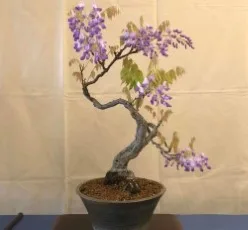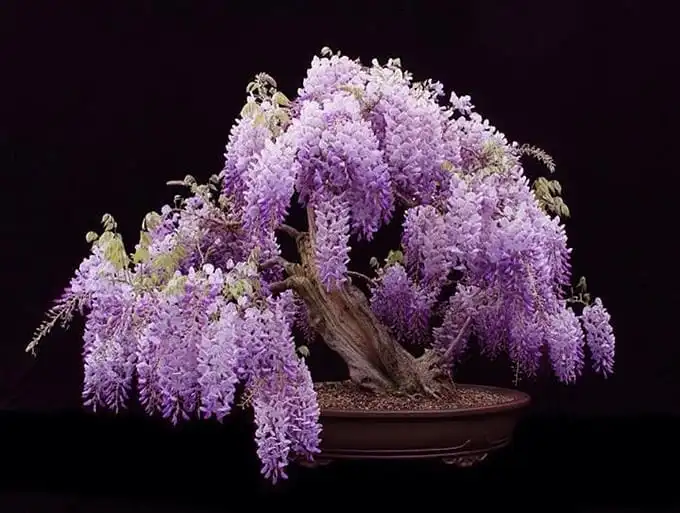Introduction
Imagine, if you will, a miniature tree, its gnarled trunk supporting cascades of purple, fragrant flowers that seem almost too beautiful to be real. This is the enchanting world of the wisteria bonsai, a living art form that captures the imagination and transforms spaces into realms of ethereal beauty. My name is Anitha, and I’ve been passionately involved in the cultivation of bonsai trees for over a decade, with a particular fondness for the wisteria. Its mesmerizing blooms and intricate growth patterns present a unique set of challenges and rewards. Unlike any other bonsai, the wisteria demands patience and dedication, yet rewards the attentive caretaker with sights and scents that are truly captivating. This guide aims to unravel the mysteries of wisteria bonsai care, ensuring your success in nurturing these magnificent miniatures.
Unveiling the Wisteria Bonsai
Species Spotlight
Wisteria bonsai trees, with their ethereal allure, primarily hail from two celebrated species: the Chinese Wisteria (Wisteria sinensis) and the Japanese Wisteria (Wisteria floribunda). The Chinese Wisteria is renowned for its vigorous growth and the ability to bloom even before the foliage appears, a spectacle that leaves enthusiasts spellbound. Its flowers, typically a deep violet, hang in shorter clusters compared to its Japanese counterpart. On the other hand, Japanese Wisteria enchants with its longer, more graceful flower clusters, which can range from white and pink to a deep purple, often creating a romantic, curtain-like display. Each species offers a unique charm, allowing bonsai artists to weave magic into miniature landscapes.
Advantages of Wisteria Bonsai
The wisteria bonsai is a coveted masterpiece in the bonsai world for several reasons. Its cascading flowers, which drape gracefully over its branches in the spring, can transform any space into a fragrant, fairy-tale garden. Beyond its aesthetic appeal, the wisteria bonsai is also celebrated for its versatility and adaptability to various bonsai styles, including informal upright, cascade, and semi-cascade. This adaptability, combined with the stunning visual display it offers, makes the wisteria bonsai a rewarding challenge for both novice and experienced enthusiasts alike.
Considerations before Acquiring
Before welcoming a wisteria bonsai into your home, it’s crucial to consider certain factors. The wisteria’s growth rate is one, as this vigorous grower demands both space and patience to sculpt into a miniature masterpiece. Maintenance is another key consideration; wisteria bonsai require regular pruning to maintain shape and encourage flowering. Additionally, understanding the species-specific needs, such as sunlight preferences and watering requirements, is essential for your wisteria bonsai to thrive. Therefore, pondering these elements beforehand ensures that your bonsai journey with wisteria is as enchanting as the tree itself.
Cultivating Your Wisteria Bonsai

Location & Environmental Considerations
To ensure your wisteria bonsai flourishes, providing it with the perfect environment is critical. Ideal light conditions involve placing your bonsai in a spot where it receives full sun throughout the morning with some protection from the intense afternoon sun. Wisterias adore the warmth and light to bloom but appreciate a break from the peak afternoon heat. Temperature wise, they are hardy but do need protection from frost in the colder months. Tucking them away from frosty conditions can prevent damage to their delicate flowering potential. Good air circulation is another non-negotiable for keeping your wisteria bonsai healthy, aiding in preventing disease and promoting robust growth.
The Art of Watering
Watering your wisteria bonsai correctly is both an art and a science. The goal is to maintain a balance where the soil remains moist but not waterlogged. Checking the soil’s moisture level before watering is crucial; this can be done by gently poking your finger into the soil. If the top inch feels dry, it’s time to water. Employ a gentle watering technique, allowing the water to soak in slowly, ensuring it reaches the roots without eroding the soil. Avoid the common pitfall of overwatering, as this can lead to root rot and other health issues for your bonsai.
Feeding the Flourish
Nourishing your wisteria bonsai appropriately will encourage its stunning blooms and healthy growth. Wisterias have specific fertilizer needs, requiring a formula low in nitrogen and high in potassium and phosphorus to support their flowering and root development. During the growing season, a weekly feeding schedule is recommended, tapering off as the season transitions to fall and stopping completely during the dormant winter period. Selecting the right fertilizer and adhering to a consistent feeding routine will empower your wisteria to reach its full, breathtaking potential.
Nurturing Your Miniature Marvel


The Art of Pruning
Proper pruning is a critical aspect of wisteria bonsai care, essential for maintaining its shape, encouraging flower production, and controlling growth. Pruning should primarily occur in early spring before the leaves emerge or immediately after the flowering period to avoid cutting off the next season’s blooms. Focus on removing dead or overcrowded branches that detract from the tree’s overall structure. Additionally, pay attention to bud placement when pruning; cutting just above a well-placed bud can direct new growth in the desired direction. Regular pinching of new shoots throughout the growing season is also vital for controlling the wisteria’s vigorous growth and encouraging a denser canopy.
Wiring for Shape and Style
Bonsai wiring is an art form that allows you to sculpt the direction and form of your wisteria bonsai, enhancing its natural beauty and character. The process involves carefully wrapping wire around the branches, gently bending them into the desired shape. There are two primary techniques: using aluminum wire for its flexibility and ease of manipulation, or copper wire, which is stronger and better for holding heavier branches in place. Begin wiring in the dormant season to minimize stress on the tree. Monitor the wires regularly to ensure they don’t cut into the growing wood, and remove them at the appropriate time to prevent damage. The strategic use of wiring can dramatically improve the structure and style of your wisteria bonsai, resulting in a more aesthetically pleasing and harmonious appearance.
Repotting for Continued Growth
Repotting your wisteria bonsai every 2-3 years is essential for its health and continued growth. This process revitalizes the soil, giving the tree access to fresh nutrients, and allows for management of the root system, encouraging more vigorous growth. When choosing a new pot, ensure it is slightly larger than the current one to accommodate growth, and that it has adequate drainage to prevent water logging. A well-draining soil mix, typically consisting of akadama, pumice, and lava rock, is vital for the health of the root system. During repotting, carefully trim the roots, removing any that are dead or overly long, to encourage a more compact and healthy root structure. Repotting is best done in early spring before the growing season begins, ensuring your wisteria bonsai continues to thrive and enchant for years to come.
Troubleshooting Common Wisteria Bonsai Ailments
Identify Common Issues
Even the most diligently cared for wisteria bonsai can encounter its share of issues. Yellowing leaves, a common symptom, can arise from a variety of factors including over-watering, under-watering, or nutrient deficiencies. A more disheartening problem for enthusiasts is when their bonsai fails to flower, often due to inadequate sunlight, improper pruning, or over-fertilization with high nitrogen content. Pest infestations, particularly from aphids and spider mites, pose another significant threat to the health and beauty of your miniature marvel.
Prevention and Treatment
Preventing these common problems begins with good cultural practices. To combat yellowing leaves, ensure you’re maintaining a consistent watering schedule where the soil is allowed to dry slightly between waterings, and adjust your feeding regime to address potential nutrient imbalances. Encouraging your wisteria bonsai to bloom requires adequate sunlight exposure and correct pruning techniques to promote flower bud formation. Use a fertilizer low in nitrogen and high in potassium and phosphorus during the growing season to support flowering. For pest infestations, regular inspection of your bonsai will allow early detection. Treat affected areas with organic pesticides or a gentle soap solution, ensuring you target the undersides of leaves where pests frequently reside. Implementing these solutions and maintaining vigilant care will preserve the charm and health of your wisteria bonsai, enabling it to thrive and enchant.
Witnessing the Wisteria Spectacle
The Joy of Bonsai Blooms
The moment your wisteria bonsai erupts in a cascade of delicate blooms is nothing short of magical. This spectacle not only showcases the aesthetic pinnacle of your efforts but also symbolizes a deep connection between you and your miniature marvel. Witnessing the lavender hues and experiencing the sweet fragrance of the flowers are rewards that transcend mere visual pleasure. They resonate on an emotional level, celebrating your dedication, patience, and the subtle artistry that bonsai cultivation demands. It’s a personal triumph as much as it is a nature’s spectacle, serving as a vivid reminder of the beauty that can flourish from careful, attentive nurture.
Sharing Your Bonsai Journey
Every bonsai story is a tapestry of triumphs, challenges, and invaluable lessons learned. Sharing your wisteria bonsai’s journey with the wider bonsai community not only enriches your own experience but also inspires and educates others. Whether it’s through social media, bonsai forums, or local club meetings, contributing your insights, successes, and even setbacks offers a wellspring of collective wisdom. Documenting your bonsai’s progress, from the initial shaping to the thrilling bloom season, creates a visual and narrative chronicle that can guide and motivate fellow enthusiasts. Encourage and support one another in this shared passion, for every story told is a seed planted in the garden of communal knowledge and fellowship.
Conclusion
In this guide, we’ve explored the meticulous care wisteria bonsai demand, from pruning for shape to troubleshooting common ailments. Mastering these practices ensures the breathtaking spectacle of blooms, symbolizing a unique bond between gardener and nature. We encourage you to begin your own wisteria bonsai adventure, armed with the knowledge shared here. For further learning, connect with reputable organizations such as the American Bonsai Society or participate in forums like Bonsai Empire. With over a decade of experience in bonsai cultivation, I am committed to delivering accurate and insightful information to help your bonsai flourish. Embark on this rewarding journey, and witness the transformation from a simple plant to a living work of art.
